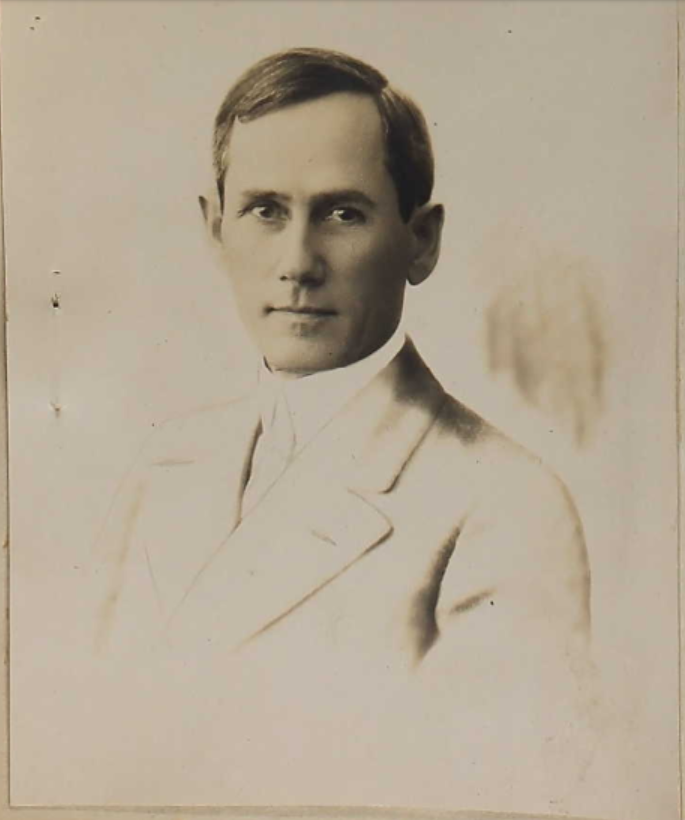 |
| Fanny Alice Gowdy The Saint Paul Globe, 1903 |
What is more, Miss Gowdy is also in love -- with Mr. Mansfield. And here Uncle Sam, after allowing them to be together for a long time, has separated them almost as far as he possibly could. No wonder Mr. Mansfield wants to get back to France, and Miss Gowdy is anxious that he should be there. ("Four New American Romances," The Saint Paul Globe, Saint Paul, Minnesota, 6 Dec 1903, page 30.)
The courtship of Fanny Gowdy and Robert Mansfield was a favorite topic in the gossip columns of many newspapers across the country and abroad. It is not surprising; they were both young, attractive, and accomplished.
Fanny Alice Gowdy was born on March 6, 1870, in Arlington, Rush County, Indiana, to John K. Gowdy and Eve Eliza Gordon. She was raised as an only child, since her brother died two weeks after she was born. In 1887, 17-year-old Fanny graduated from Rushville High School as valedictorian of her class with special honors in elocution and literature. She went on to study literature, art, and linguistics at DePauw University in Greencastle, Indiana.
 |
| Robert Emmett Mansfield Passport photo from Ancestry.com |
However, Mansfield was soon called away to Valparaiso, Chile, on a political assignment. The consular position in Chile was a highly sought-after office, but Mr. Mansfield was determined not to stay longer than necessary. He soon petitioned for a transfer.
With so many thousand miles of territory between the young people their happiness could not be complete and therefore Mr. Mansfield can certainly be pardoned for his anxiety to effect a transfer to Calais, which is within easy reach of Paris. The members of the Indiana delegation, who have hearts as big as the side of a hill, certainly will do whatever is in their power to help Mr. Mansfield, who is popular with them. (New Castle Daily Press, New Castle, Indiana, 24 Oct 1903, page 1.)
 |
| Fanny Gowdy, age 28, and her mother in Paris |
Several newspapers credit Fanny Gowdy with the establishment of a popular literary salon. This is regarded as a wonderful achievement by the Europeans, who understand the great importance of these gatherings [are] ostensibly social, but also frequently political. ("Four New American Romances", The Saint Paul Globe, Saint Paul, Minnesota, 6 Dec 1903, page 30.)
In 1900, Tennessee artist Willie Betty Newman, who was living in Paris, painted a remarkable portrait of Fanny Gowdy. "Portrait of Miss Gowdy" was heralded as one of the best portraits of the year and received an honorable mention at the 1900 Paris Salon.
 |
| "Portrait of Miss Gowdy" by Willie Betty Newman |
Another publication mentions the painting's "exquisite color arrangement." I would love to see the original color palette of the portrait; unfortunately, I have only found it reproduced in black and white. I'm not exactly sure where the painting is now, but it may be in storage at the Smithsonian. Perhaps it will be displayed again some day so I can see it in person!
 |
| Washington Times, 14 Mar 1906 |
 |
| San Fransisco Call. 12 Jul 1903 |
In June of 1906, the Mansfields moved to Lucerne, Switzerland, where Robert served as consul. After four years abroad, the couple returned home to Indiana for good. During her lifetime, Fanny visited or resided in many countries including France, Switzerland, Germany, Italy, Holland, Belgium, Sweden, Denmark, and Canada.
Robert died at Methodist Hospital in Indianapolis on September 18, 1925 after a long illness. Fanny died at the age of 67 in her hometown of Rushville on March 23, 1937. The Mansfields never had any children, so there are no descendants. Although I am only distantly related to Fanny (she is my 1st cousin 4 times removed), I felt compelled to recount her fascinating life.


































